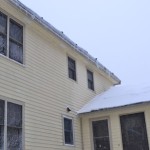By Mark J. Donovan
If you own a home in an area of the country where you get cold and snowy winters, then you’ve probably already experienced ice dams. If, on the other hand, you are a first-time homeowner or a new transplant who has just purchased a home in a region of the country with harsh winters, then you may be unfamiliar with ice dams. If you fall into one of these two latter types of homeowner categories, then it’s important that you become familiar with ice dams and know how to resolve them quickly.
Ice dams form along roof edges when snow melts on the roof. They can cause major damage to the home, including water damage and structural damage. They can also cause mold and mildew growth.
Ice dams are caused by warm, moist air from the main living area of the home rising into the attic and getting trapped inside it. This air heats up the underside of the roof sheathing, which in turn causes the snow to melt on the roof. As the snow melts, the water drips down toward the roof edges where it then refreezes. Over just a couple of days, the refreezing snowmelt forms ice ridges known as ice dams.
The ice dams prevent additional snowmelt from dripping off the roof, which causes them to become bigger. And that’s just the beginning of the problems.
As the water backs up underneath the roof shingles, it inevitably works its way into cracks in the roof sheathing, where it then begins to drip into the attic. From there, drywall ceilings become soaked and damaged, and mold and mildew growth begin to form in the attic. However, the water damage doesn’t stop in the attic. Often the water finds its way further down into the home and sometimes between wall paint and drywall, causing large water bubbles to form that eventually burst. Also, when the temperatures drops, the water underneath the shingles freezes up, causing the shingles to buckle and become potentially permanently damaged.
The best long-term solution for preventing ice dams is to ensure that your attic is well-insulated so that no warm air from the lower living areas of the home makes it up into it.
Secondly, it is critical that the attic have sufficient and unblocked ventilation. Ventilation should include soffit vents near the roof eaves, as well as a ridge vent or gable vents near the top of the roof. The ventilation ensures that any warm air that does enter the attic is quickly dissipated before it can cause any roof snowmelt.
If you do see ice dams forming on your home’s roof edges, then one quick solution for preventing water issues is to place ice melt socks on the roof edges. Ice melt socks are simple to make. Simply pour a couple of pounds of ice melt into lengths of nylon stockings. Then tie off the stockings.
Next, place an ice melt sock every 4 to 6 feet along the roof edge, on top of the ice dam ridges, making sure to place them perpendicular to the roof’s edge. In just a few hours, they will begin to melt channels into the ice dam ridges so that additional roof snowmelt can drain off the roof.
When the warm weather returns, resolve your attic’s insulation and ventilation shortcomings to prevent ice dams from forming in the future.













